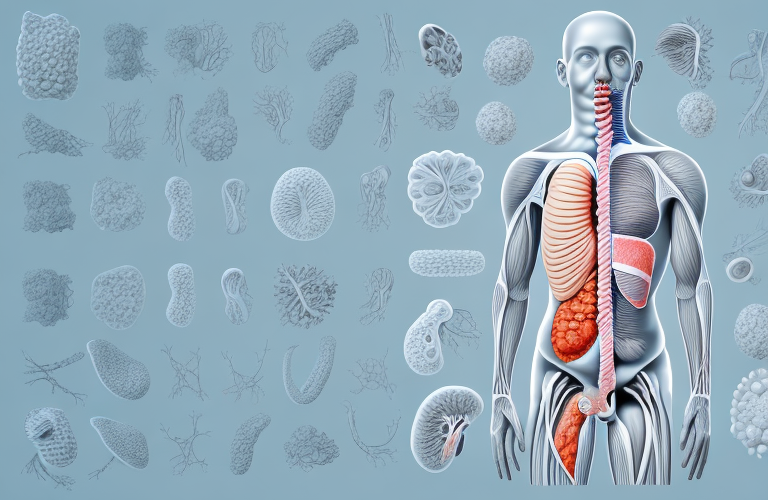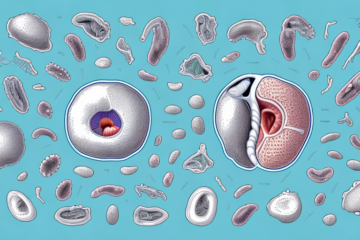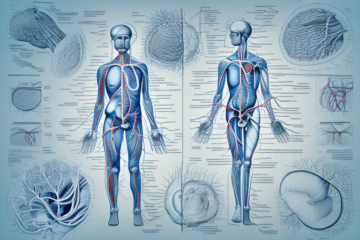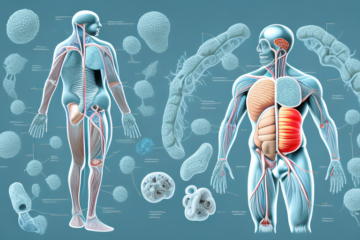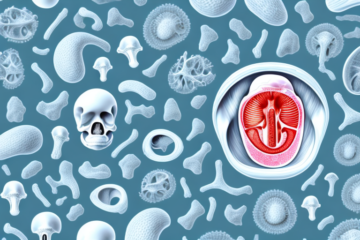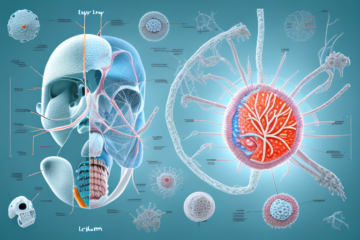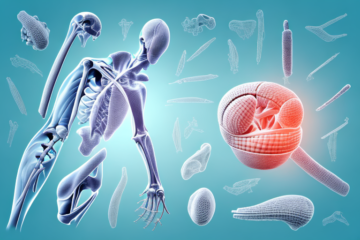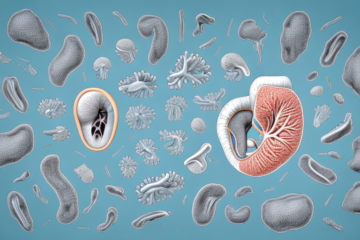The oesophagus, also known as the esophagus, is a muscular tube that connects the throat to the stomach. Understanding its anatomy and function is key to maintaining a healthy digestive system and preventing serious conditions such as esophageal cancer or gastroesophageal reflux disease (GERD).
Understanding the anatomy of the oesophagus
The oesophagus is approximately 25 centimetres long and runs down the back of the throat, behind the trachea or windpipe. It passes through the diaphragm muscle before connecting to the stomach. The inner lining of the oesophagus is made up of mucous membranes, which secrete mucus to help the passage of food. The outer layer of the oesophagus is composed of smooth muscle, which helps propel the food towards the stomach through coordinated contractions.
The oesophagus also has two sphincters, which are circular muscles that act as valves to control the flow of food. The upper oesophageal sphincter is located at the top of the oesophagus and opens to allow food to enter from the mouth. The lower oesophageal sphincter is located at the bottom of the oesophagus and opens to allow food to pass into the stomach. These sphincters also help prevent stomach acid from flowing back up into the oesophagus, which can cause heartburn and other digestive problems.
How does the oesophagus work?
The oesophagus works through a series of muscular contractions known as peristalsis, which helps move food efficiently towards the stomach. When food enters the oesophagus from the mouth, the muscles in the oesophagus start contracting rhythmically behind the food bolus. This propels the food further down the tube. The lower sphincter muscle then relaxes to allow the food to enter the stomach. The entire process is coordinated by the brain and nervous system.
In addition to its role in transporting food, the oesophagus also plays a crucial role in preventing the contents of the stomach from flowing back up into the oesophagus. This is achieved through the lower oesophageal sphincter, a ring of muscle at the bottom of the oesophagus that acts as a valve to prevent the backflow of stomach acid and other contents. If this sphincter is weakened or damaged, it can lead to a condition known as gastroesophageal reflux disease (GERD), which can cause heartburn, chest pain, and other uncomfortable symptoms.
The role of the oesophagus in digestion
The oesophagus plays a crucial role in the digestive system, as it transports food from the mouth to the stomach. The mucus that lines the inner layer of the oesophagus lubricates the passage of food, making it easier for the stomach to break it down into small particles. Without an oesophagus, our bodies would not be able to digest food efficiently.
In addition to its role in transporting food, the oesophagus also has a protective function. When we swallow, a flap called the epiglottis closes over the trachea, preventing food from entering the lungs. The oesophagus then contracts in a coordinated manner to push the food down towards the stomach. This process is known as peristalsis and is essential for preventing food from getting stuck in the oesophagus.
Common conditions affecting the oesophagus
Despite its important role, the oesophagus is also prone to several conditions. Acid reflux, or GERD, is a common condition that affects the oesophagus. This occurs when stomach acid flows back into the oesophagus, causing irritation to the lining and resulting in symptoms such as heartburn. Other common conditions affecting the oesophagus include dysphagia (difficulty in swallowing), oesophageal strictures (narrowing of the oesophagus due to inflammation or scar tissue), and oesophageal cancer.
It is important to note that lifestyle factors can contribute to the development of these conditions. For example, smoking, alcohol consumption, and obesity have all been linked to an increased risk of developing oesophageal cancer. Additionally, certain foods and medications can exacerbate symptoms of acid reflux and dysphagia. It is important to speak with a healthcare provider if you are experiencing any symptoms related to oesophageal conditions, as early detection and treatment can improve outcomes.
Esophageal cancer: Causes, symptoms and treatment options
Esophageal cancer is a serious condition that affects the oesophagus. The most common types of esophageal cancer are squamous cell carcinoma and adenocarcinoma. The risk factors for esophageal cancer include smoking, heavy alcohol consumption, gastroesophageal reflux disease (GERD), and obesity. Symptoms of esophageal cancer include difficulty swallowing, chronic cough, chest pain, and weight loss. Treatment options for esophageal cancer include surgery, chemotherapy, and radiation therapy, depending on the stage and type of cancer. Early diagnosis and treatment are crucial for a good outcome.
It is important to note that esophageal cancer is often diagnosed at an advanced stage, which can make treatment more difficult. Therefore, it is recommended that individuals who are at a higher risk for esophageal cancer, such as those with a history of GERD or heavy alcohol consumption, undergo regular screenings to detect any abnormalities early on. Additionally, making lifestyle changes such as quitting smoking and reducing alcohol intake can help lower the risk of developing esophageal cancer.
Gastroesophageal reflux disease (GERD): Symptoms and treatment options
GERD is a common condition that affects the oesophagus. It occurs when the lower sphincter muscle fails to close properly, allowing stomach acid to flow back into the oesophagus. Symptoms of GERD include heartburn, regurgitation, chest pain, and difficulty swallowing. Treatment for GERD includes lifestyle changes such as weight loss, limiting alcohol and caffeine, and avoiding certain foods that trigger symptoms. Medications such as antacids, proton pump inhibitors, and H2 receptor antagonists may also be prescribed to reduce acid production in the stomach.
In addition to lifestyle changes and medications, there are also surgical options available for treating GERD. One such option is fundoplication, which involves wrapping the upper part of the stomach around the lower oesophageal sphincter to strengthen it and prevent acid reflux. Another surgical option is the LINX device, which is a small ring of magnetic beads that is placed around the lower oesophageal sphincter to help keep it closed.
It is important to seek medical attention if you experience symptoms of GERD, as untreated acid reflux can lead to complications such as oesophagitis, strictures, and Barrett’s oesophagus. Barrett’s oesophagus is a condition in which the cells lining the oesophagus change and become precancerous, increasing the risk of oesophageal cancer. Regular monitoring and treatment can help prevent these complications and improve quality of life for those with GERD.
How to maintain a healthy oesophagus
Maintaining a healthy weight, avoiding smoking and excessive alcohol consumption, and eating a balanced diet rich in fruits and vegetables can help prevent oesophageal problems. Chewing food slowly and thoroughly, avoiding large meals before bedtime, and staying upright after eating can also help reduce the risk of GERD. Good oral hygiene and regular dental check-ups can help prevent oesophageal infections caused by bacteria. Regular exercise is also beneficial for maintaining a healthy digestive system.
In addition to the above, it is important to limit the intake of acidic and spicy foods, as they can irritate the oesophagus and lead to discomfort. It is also recommended to avoid wearing tight clothing around the waist, as this can put pressure on the stomach and increase the risk of acid reflux.
If you experience persistent symptoms such as heartburn, difficulty swallowing, or chest pain, it is important to seek medical attention. Your doctor may recommend further tests or treatment options, such as medication or surgery, to address any underlying issues and prevent further damage to the oesophagus.
Lifestyle changes to prevent oesophageal problems
Some simple lifestyle changes can help prevent oesophageal problems and improve overall digestive health. These include eating smaller meals more frequently throughout the day, avoiding tight-fitting clothing that puts pressure on the stomach, and avoiding alcohol and caffeine before bedtime. Elevating the head of the bed can also help reduce the risk of GERD symptoms at night.
In addition to these lifestyle changes, maintaining a healthy weight can also help prevent oesophageal problems. Excess weight can put pressure on the stomach and increase the risk of acid reflux and other digestive issues. Regular exercise and a balanced diet can help achieve and maintain a healthy weight.
Another important factor in preventing oesophageal problems is quitting smoking. Smoking can weaken the lower oesophageal sphincter, which can lead to acid reflux and other digestive issues. Quitting smoking can also improve overall health and reduce the risk of other health problems.
Diagnosis of oesophageal disorders: What to expect
If you are experiencing symptoms of oesophageal problems, your doctor may recommend several tests to diagnose the problem. These tests may include X-rays, endoscopy, manometry (measuring muscle contractions), and pH monitoring (measuring acid levels in the oesophagus). Your doctor will then recommend a treatment plan based on the diagnosis.
In conclusion, the oesophagus is a crucial part of the digestive system. Understanding its anatomy and function can help prevent serious conditions and maintain good digestive health. If you are experiencing any symptoms of oesophageal problems, it is important to seek medical attention promptly for early diagnosis and treatment.
It is important to note that some oesophageal disorders may require surgery as a treatment option. Surgery may be recommended for conditions such as achalasia, a condition where the muscles of the oesophagus do not relax properly, or for the removal of cancerous tumours. Your doctor will discuss the risks and benefits of surgery with you and help you make an informed decision.
Additionally, lifestyle changes may be recommended to manage oesophageal disorders. These may include avoiding certain foods that trigger symptoms, losing weight, quitting smoking, and elevating the head of your bed while sleeping. Your doctor may also recommend medications to manage symptoms such as acid reflux or to help relax the muscles of the oesophagus.

